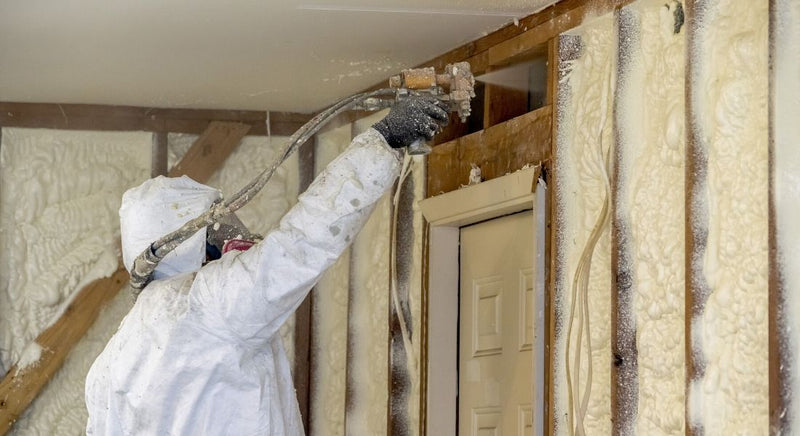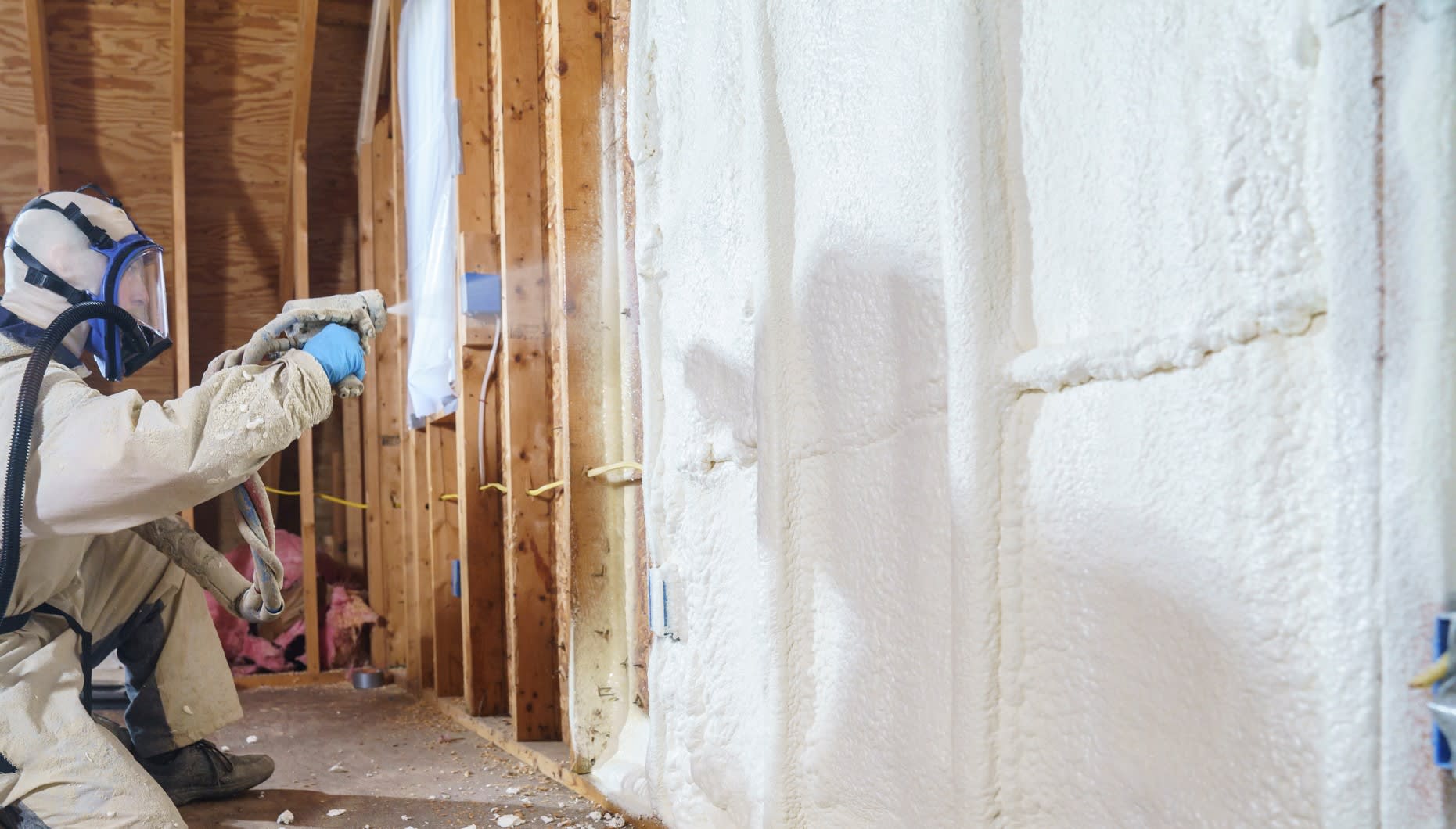Leading Applications of Spray Foam for Residential and Commercial Properties
Leading Applications of Spray Foam for Residential and Commercial Properties
Blog Article
Spray Foam: The Ultimate Remedy for Air Sealing and Insulation
Spray foam insulation has become a leading solution for effective air sealing and thermal insulation, offering a distinct combination of homes that establish it besides standard techniques. Its capability to broaden and fill gaps makes it particularly effective in protecting against air leak, which can dramatically influence energy effectiveness. However, understanding the complete range of its benefits, installation procedures, and contrasts with other insulation types is critical for making educated decisions. As we check out these aspects, the effects for both new constructions and retrofits become significantly considerable. What elements should affect your option?
What Is Spray Foam?
Spray foam is a flexible insulation product that integrates the concepts of air sealing and thermal resistance to improve power effectiveness in structures. Composed mostly of polyurethane or various other comparable compounds, spray foam is used as a fluid that broadens upon call with surface areas, developing a strong, continuous layer of insulation. This special residential property permits it to fill up voids, splits, and spaces that standard insulation materials may ignore, providing an exceptional air seal.
There are two major sorts of spray foam: open-cell and closed-cell. Open-cell spray foam is lighter and more versatile, using excellent sound absorption and a lower R-value per inch - Spray Foam. On the other hand, closed-cell spray foam is denser, supplying a higher R-value, wetness resistance, and included structural honesty to constructing parts
The application process generally includes customized devices, guaranteeing a seamless application that follows various substratums, including concrete, timber, and steel. This adaptability makes spray foam appropriate for both new constructions and retrofitting existing structures. Its ability to produce an airtight barrier considerably adds to lowering energy intake and enhancing interior air high quality, therefore making it a favored option among homeowners and building contractors alike.
Advantages of Spray Foam Insulation
One of one of the most significant advantages of spray foam insulation is its extraordinary capacity to produce a continual air barrier, which efficiently lessens power loss. Unlike traditional insulation products, spray foam increases to load splits and gaps, ensuring that air leak is considerably reduced. This characteristic not just improves power effectiveness yet likewise brings about reduce energy bills gradually.
Additionally, spray foam insulation supplies superior thermal resistance, adding to an extra stable indoor setting. Its high R-value per inch enables efficient insulation in constrained spaces, making it suitable for attic rooms, walls, and crawl areas. The moisture-resistant properties of spray foam assistance stop mold and mildew and mold growth, promoting healthier living conditions.
One more essential advantage of spray foam insulation is its sound-dampening qualities (Spray Foam). It efficiently decreases noise transmission between spaces, producing a quieter and extra comfy home setting. The resilience of spray foam likewise sticks out, as it does not droop or clear up gradually, maintaining its performance throughout its life-span
Just How Spray Foam Functions
Recognizing just how spray foam insulation functions is necessary for valuing its efficiency in air sealing and thermal resistance. Spray foam insulation contains two key parts: isocyanate and polyol material. When these elements are mixed, they undertake a chain reaction that triggers the material to expand swiftly, developing a dense foam that fills fractures, gaps, and dental caries.
As the foam increases, it follows surfaces, developing an airtight seal that significantly lowers air infiltration. This particular makes spray foam insulation extremely effective at protecting against drafts and wetness infiltration, which can cause energy loss and damages over time. Furthermore, the closed-cell variant of spray foam uses superior thermal resistance as a result of its rigid framework, effectively decreasing heat transfer.
The one-of-a-kind residential properties of spray foam allow it to adapt to irregular surfaces, making sure comprehensive protection and a smooth barrier. Therefore, spray foam insulation not just boosts energy effectiveness yet also contributes to boosted indoor air high quality by minimizing the accumulation of toxins and irritants. Ultimately, comprehending the technicians behind spray foam emphasizes its role as a remarkable selection for insulation and air sealing in both domestic and industrial applications.
Setup Process Summary

Prior to installment, the room must be sufficiently cleaned up and prepped, making sure that surface areas are devoid of particles, dampness, and dirt. This step is essential since contaminants can compromise adhesion and overall efficiency. Once the location is prepared, the application includes mixing both components of the spray foam, which increases upon call and fills up spaces efficiently.
Educated specialists must carry out the installation, making use of specific devices to ensure consistent protection and optimal thickness. Security safety measures, consisting of using protective equipment and making sure proper ventilation, are crucial during this procedure. After application, the foam usually cures promptly, developing a solid obstacle that enhances energy efficiency.
Contrasting Spray Foam to Traditional Insulation
When evaluating insulation choices, spray foam insulation stands out in contrast to typical materials such as fiberglass and cellulose. Unlike fiberglass and cellulose, which can enable air seepage, spray foam increases upon application, filling spaces and gaps to create a closed seal.
In addition, spray foam gives a higher R-value per inch than standard insulation kinds, offering more effective thermal resistance in a thinner profile. This characteristic is especially valuable in spaces with limited cavity depth. Spray foam is immune to dampness and mold and mildew development, which can be a considerable worry with cellulose and fiberglass, especially in damp atmospheres.
However, spray foam insulation usually brings more tips here a higher upfront price than its typical equivalents. House owners need to evaluate this initial investment versus long-lasting energy savings and efficiency advantages. Eventually, while both insulation types offer their function, spray foam emerges as an advanced service for modern insulation demands, especially in terms of air securing and thermal effectiveness.

Final Thought
In recap, spray foam insulation represents a highly efficient option for attaining optimal air sealing and thermal resistance. Its distinct buildings, including moisture resistance and sound dampening, make it appropriate for different applications in both brand-new building and constructions and retrofitting tasks (Spray Foam). The initial costs may be greater contrasted to typical insulation products, the long-lasting benefits, such as considerable energy savings and improved interior air high quality, validate the investment and underscore its worth in modern-day building methods.
Spray foam insulation has arised as a leading option for efficient air sealing and thermal insulation, offering an unique mix of buildings that establish it apart Click This Link from conventional methods.Spray foam is a functional insulation material that combines the concepts of air sealing and thermal resistance to boost power efficiency in structures.When examining insulation options, spray foam insulation stands out in contrast to conventional products such as fiberglass and cellulose. Eventually, while both insulation types offer their purpose, spray foam arises as a more innovative service for modern-day insulation requirements, specifically in terms of air sealing and thermal performance.
In summary, spray foam insulation stands for a highly reliable service for attaining optimal air securing and thermal resistance.
Report this page